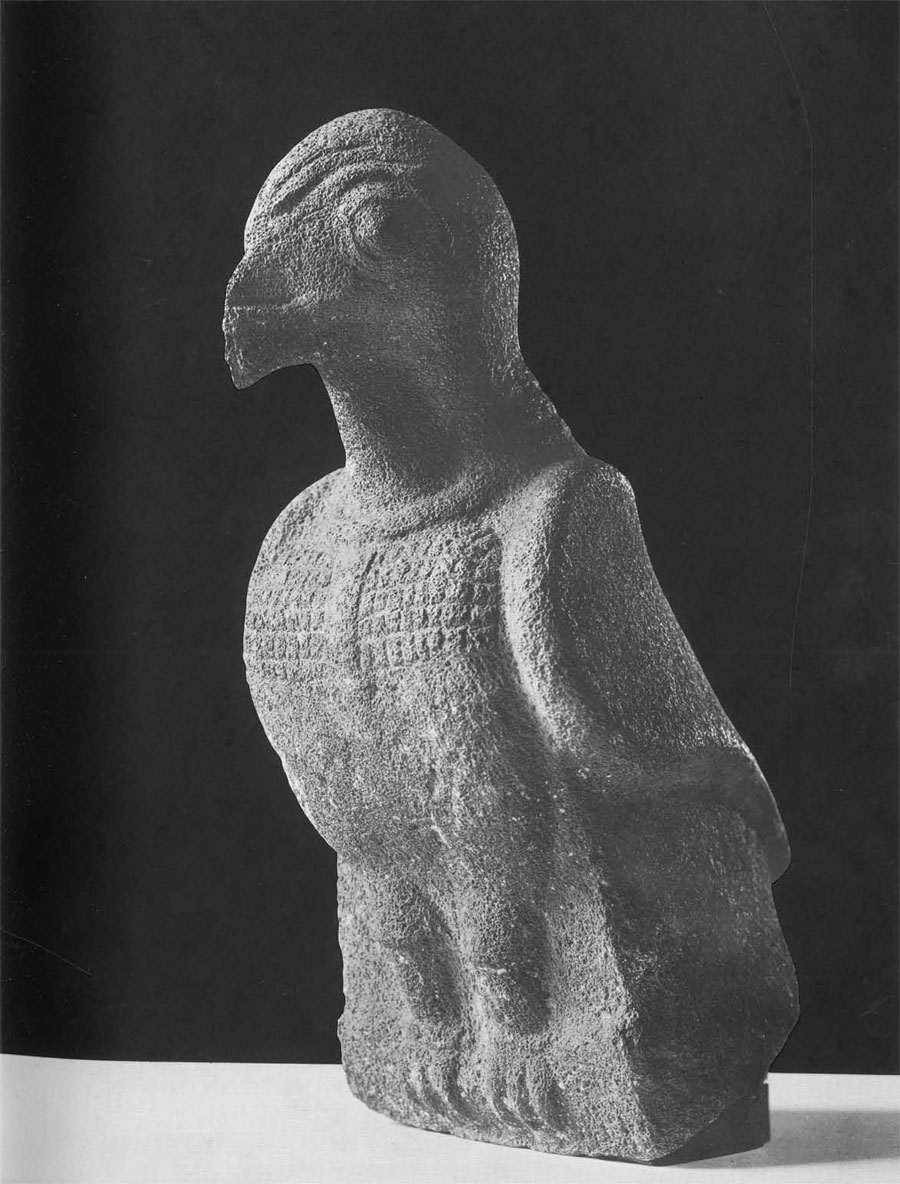
A stone hawk looks quizzically at the visitors of the special exhibit of the Lipchitz Collection. The label calls him Hittite in the general sense of the word, and the provenance of the bird is known to have been Asia Minor. Herman V. Hilprecht, Curator of the Babylonian Section of the University Museum from 1888 until 1910, acquired this piece during his travels, but no further details are known about the original home of the sculpture.
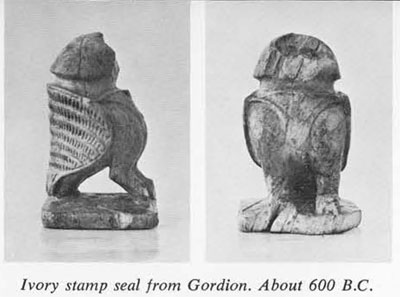
The hawk is carved in andesite or a similar slightly reddish stone with a coarse porous surface. In spite of the unpretentious medium, the sculptor gave the bird strong precise forms with accents of interesting surface detail. The hawk is seated in a compact vertical pose, more erect than the photograph suggests. He is about fifteen inches in height, and about half as much in depth from legs to tail (height 38.5 cm., width at base 17 cm., depth at tail 18.5 cm. Preservation intact except for a break in the tail). Excess stone has been left under the folded wings and around the legs to give the piece stability, but the upper part of the body is carved in the round.
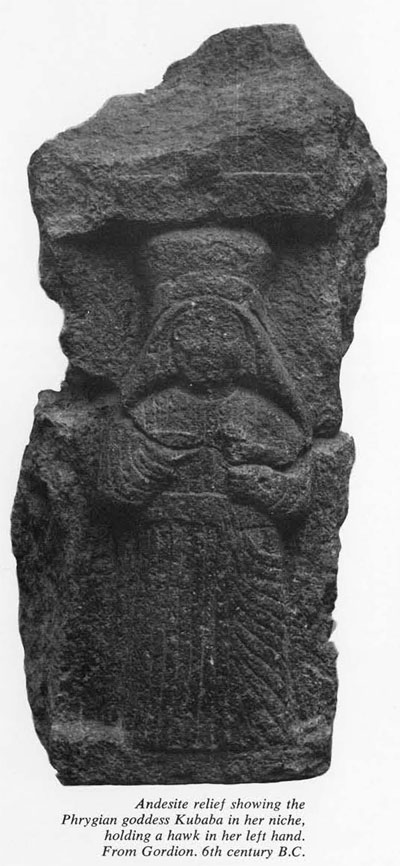 The head has a short curved beak, sheathed with an additional ridge on its upper part. The eyes are round and bulging. A semicircular moulding frames the top of each eye, descending on the side to become the edges of a veil-like cover on the neck of the bird. On the forehead, these mouldings are almost joined in a V-shaped frown, repeated by two parallel chevrons on top of the head. In the treatment of these details, a firm stylization of forms and contours becomes evident. The same principles appear in the modelling of the body. Below the beak, the throat is marked off as a sunk area. A round band resembling a solid necklace defines its lower border. A central band hangs down from the necklace, dividing the area of the chest into two curved panels, each filled with an incised checkerboard pattern. The incisions continue into the corners between necklace and wings. From the chest down, the front is gently modeled but sturdy. The upper legs have horizontal demarcations to produce another ‘sheathed’ effect. Each claw projects with three talons over the base ledge.
The head has a short curved beak, sheathed with an additional ridge on its upper part. The eyes are round and bulging. A semicircular moulding frames the top of each eye, descending on the side to become the edges of a veil-like cover on the neck of the bird. On the forehead, these mouldings are almost joined in a V-shaped frown, repeated by two parallel chevrons on top of the head. In the treatment of these details, a firm stylization of forms and contours becomes evident. The same principles appear in the modelling of the body. Below the beak, the throat is marked off as a sunk area. A round band resembling a solid necklace defines its lower border. A central band hangs down from the necklace, dividing the area of the chest into two curved panels, each filled with an incised checkerboard pattern. The incisions continue into the corners between necklace and wings. From the chest down, the front is gently modeled but sturdy. The upper legs have horizontal demarcations to produce another ‘sheathed’ effect. Each claw projects with three talons over the base ledge.
The wings are shield-like with round tops, profiled around the upper edges to create a strikingly plastic effect in front and three-quarter view. In the treatment of the back there is a slight breach of symmetry. The upper curves of the wings continue as intersecting grooves down to the tail. The area between the wings is incised with overlapping groups of curved lines which descend from the ‘veil’ on the hawk’s neck. On the bird’s left side, the parallel curves are allowed to continue to the border of the right wing; but the curves on the right side stop at the edge of the left panel as if folded under. An additional group of four curved lines cuts across the upper back, disturbing the logic of the pattern.
This description of the bird has emphasized the compactness of form and proportions, the deliberate reinforcement of plastic divisions by ridges (such as the edges of the wings, the ‘sheath’ effects), and the use of linear detail of non-naturalistic character (the checkerboard pattern, the chevrons). Such stylistic details take the andesits hawk right out of the Hittite into the post-Hittite world of Asia Minor, and we may tentatively suggest, to that part of Asia Minor which was under Phrygian rule.
Phrygian art, as it is now becoming known from the University Museum’s Gordion excavations, was found of an animal style to which the above characteristics apply. In wood and ivory carvings, in painted pottery, in coarsely painted terracotta revetments, the Phrygian artistic idiom is becoming increasingly familiar to us. It may be appropriate to compare a tiny ivory bird from Gordion with the stone hawk, because in spite of the difference in scale, a stylistic and iconographic affinity will appear.
The ivory bird from Gordion is the figural handle of a stamp-seal (height 3.8 cm., Gordion inventory BI 218). He is so squat and wide that he begins to resemble an owl rather than a hawk. But he sits erect, legs and tail carved a jour in this fine medium. His wings are neatly outlined and patterned as curved shields, and again the peculiar mannerism of the ‘necklace’ appears, in this case made part of a triangular division by the addition of ridges framing the upper legs of the bird. The head of this ivory bird is unfortunately lost, but the body forms preserve a clear stylistic imprint.
This stamp-seal was found on a floor level of a small room near the north wing of the archaic gate. It belonged to the reconstruction period after the Kimmerian invasion at Gordion, and may date anywhere in the seventh or early sixth century. The necklace on this stratified bird is thus safely attested as an authentic Phrygian fashion. The ivory bird even had a small pendant attached to the center of his collar, as if to convince us that the ornaments are more than playful surface detail. In discussions of various large statues of eagles found in Asia Minor, such necklaces had previously been suspected as signs of late, Roman manufacture. The Gordion evidence isn this as in other cases is valuable in expanding the chronological limits of certain iconographic traits.
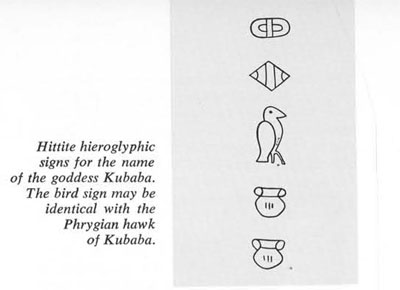 Birds of prey are a popular artistic and religious motif in Asia Minor. Hittite seals of the early second millennium B.C. carry various designs in which eagles or hawks appear as emblems by themselves or attacking their prey. This iconography was so familiar in Anatolia that the Phrygians could borrow it freely for their minor arts. When the bird of prey appears by himself and as a carving in the round, it may be difficult to assign him to a specific chronological period. The Greeks and Romans adapted much of the old Anatolian iconography to their pantheon, and the Romans in particular were fond of carving colossal birds of prey (eagles in this case, as a concession to Jupiter) as votives in open-air sanctuaries in Asia Minor. The best known eagle of this class dominates the courtyard of the Kayseri Museum. The Kayseri eagle (found at Yamula on the Halys river) sits on a pedestal supported by lions. Naturalistic modelling and fussy feather patterns take this giant eagle far from his Phrygian relatives.
Birds of prey are a popular artistic and religious motif in Asia Minor. Hittite seals of the early second millennium B.C. carry various designs in which eagles or hawks appear as emblems by themselves or attacking their prey. This iconography was so familiar in Anatolia that the Phrygians could borrow it freely for their minor arts. When the bird of prey appears by himself and as a carving in the round, it may be difficult to assign him to a specific chronological period. The Greeks and Romans adapted much of the old Anatolian iconography to their pantheon, and the Romans in particular were fond of carving colossal birds of prey (eagles in this case, as a concession to Jupiter) as votives in open-air sanctuaries in Asia Minor. The best known eagle of this class dominates the courtyard of the Kayseri Museum. The Kayseri eagle (found at Yamula on the Halys river) sits on a pedestal supported by lions. Naturalistic modelling and fussy feather patterns take this giant eagle far from his Phrygian relatives.
We do not know that the Phrygians would have carved such large animal (or for that matter, human) sculptures in the round. They excelled in minor arts, and began, somewhat timidly, to make sculpture in stone under the auspices of their oriental, neo-Hittite neighbors.
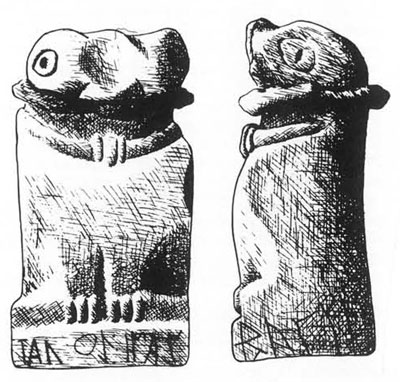
In Gordion, the initial sculptural efforts were made in limestone. Some architectural ornaments (lion protomes and relief slabs used as orthostats) were found in the monumental level destroyed by the Kimmerians. Gordion was rather far removed from the experienced sculptural centers of Eastern Anatolia. They Phrygians at Ankara were somewhat better off, and experimented with andesite. Several of their andesite orthostats decorated with animal reliefs are in the Hittite Museum at Ankara. These reliefs are the more accomplished counterparts of the limestone orthostats from Gordion.
In the course of the Phrygian ‘restoration’ period after the Kimmerian invasion, all was not lost sculpturally. A major effort was directed to the carving of idols, cut reliefs, and cult statues of the great Phrygian goddess Kubaba-Kunlie. Her cult and much of her iconography had probably been borrowed from the city of Carchemish, to which the Phrygians were close, politically and culturally, in the days of Midas. Kubaba or Matar Kublie soon became the most famous goddess of the Phrygians.
We do not have the earliest sculptural versions of the Phrygian Kubaba; at least, it is difficult to adduce sufficient proof in this context for eighth century Phrygian Kubaba sculptures.
The later Phrygian Kubabas, however, carved in andesite in Gordion, Ankara, and elsewhere, often are characterized by the attribute of a bird of prey held in the left hand of the goddess. In hieroglyphic Hittite, a bird is the second sign in the name of Kubaba. This sign may stand for the same bird of prey so popular in Phrygian art, although the precise identification is disputed. In any case, the association of the Phrygian Kubaba with a hawk-like bird (R.D. Barnett suggested an identification as a buzzard) is well attested.
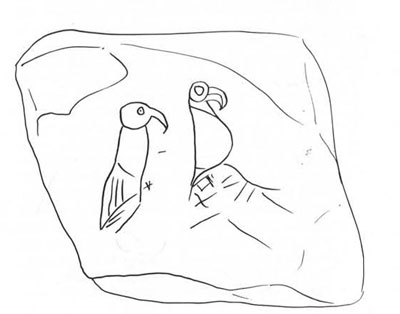
The Koerte brothers, who excavated at Gordion for one successful season in the year 1900, found a truncated torso of a trachyte (?) bird on the city mound (G. and A. Koerte, Gordion, p. 168 f., fig. 150, preserved height 24 cm.). This bird, which the German excavators considered to be of archaic workmanship, again wears a necklace. The Koerte brothers decided that such an effeminate bird had to be a semi-human siren and put her as an akroterion on top of the fanciful temple they reconstructed on paper. Now we can safely remove the 1900 bird from this undignified role and make the archaic carving into a medium-sized dedication to the Phrygian Kubaba at Gordion.
Several broken stone birds have been found scattered in the Museum’s new excavations at Gordion. The most popular carvings are made in local alabaster and represent small squatting hawks. They occur in Hellenistic and earlier levels, some of them in the fill of tumuli which were closed in the sixth century. On the day when this note was being finished at Gordion, a new alabaster bird most appropriately turned up in a sixth or fifth century level on the city mound. The small carving (height 5.6 cm., inventory S 85) represents a hawk in the familiar attitude. His beak is lost, and with it all vestiges of his menacing nature. He not only wears an alabaster necklace carved in relief but the anxious dedicant added a bronze torque around the bird’s neck, clearly emphasizing the importance of this ornament. The collar indicated real or symbolic domestication: the bird belongs to the shrine of the goddess and the small votive figure is marked as such. The votive character in this case is confirmed by an inscription on the plinth, probably giving the name of the dedicant and the purpose of the object. Unfortunately our knowledge of Phrygian is not yet precise enough to read this text as a clue to our problem.
More proof of the religious context of such carvings came recently from Bogazkoy, the site of the Hittite capital. In a small Phrygian shrine erected in front of the entrance to Hittite Temple I (Beran, MDOG 94, January 1963, p.40, figs. 9, 10), remnants of votive equipment turned up, including a pottery stand crowned by a terracotta hawk, and a stone carving, battered and vaguely modelled, but unmistakably the Phrygian bird of prey.
We could pursue the association of the Anatolian goddess Kubaba with her birds of prey to the Greek and West side of Asia Minor, where the Ephesian Artemis, pre-Greek goddess concerned with animals) is the recipient of bird votives and where a sixth century ivory statuette of a priestess is rendered as offering two hawks to her goddess. But the Ephesian hawks are no more than sixth century Greek variants on an earlier Anatolian theme.
Perhaps we may discern a much earlier religious connotation of the hawk in eighth century Gordion. On the doodle stones of Megaron II in the pre-Kimmerian level we have sketches of things, people, and animals which were dear to the imagination of the residents of Gordion. The most popular themes are pictures of lions and birds of prey, some of them accompanied by sketches of house facades. The facades may be no more important than modern children’s pictures of houses–except for our knowledge that the Phrygians carved monumental copies of such facades in the rock as symbolic houses of their goddess Kubaba. Is it fanciful to think of the bird-doodles as popular ideograms for the goddess, perhaps no more than accidentally resembling the hieroglyph in her neo-Hittite name?
The bird in the Lipchitz exhibit is an outstanding sculptural emblem of the Phrygian goddess. He was probably not carved in Gordion, but somewhere nearer the center of Anatolia, and he could hardly have been made in this good sculptural technique before the seventh or sixth century B.C.; but the artistic and religious ties with the Phrygians of Gordion make him a most welcome and appropriate resident in the University Museum.
